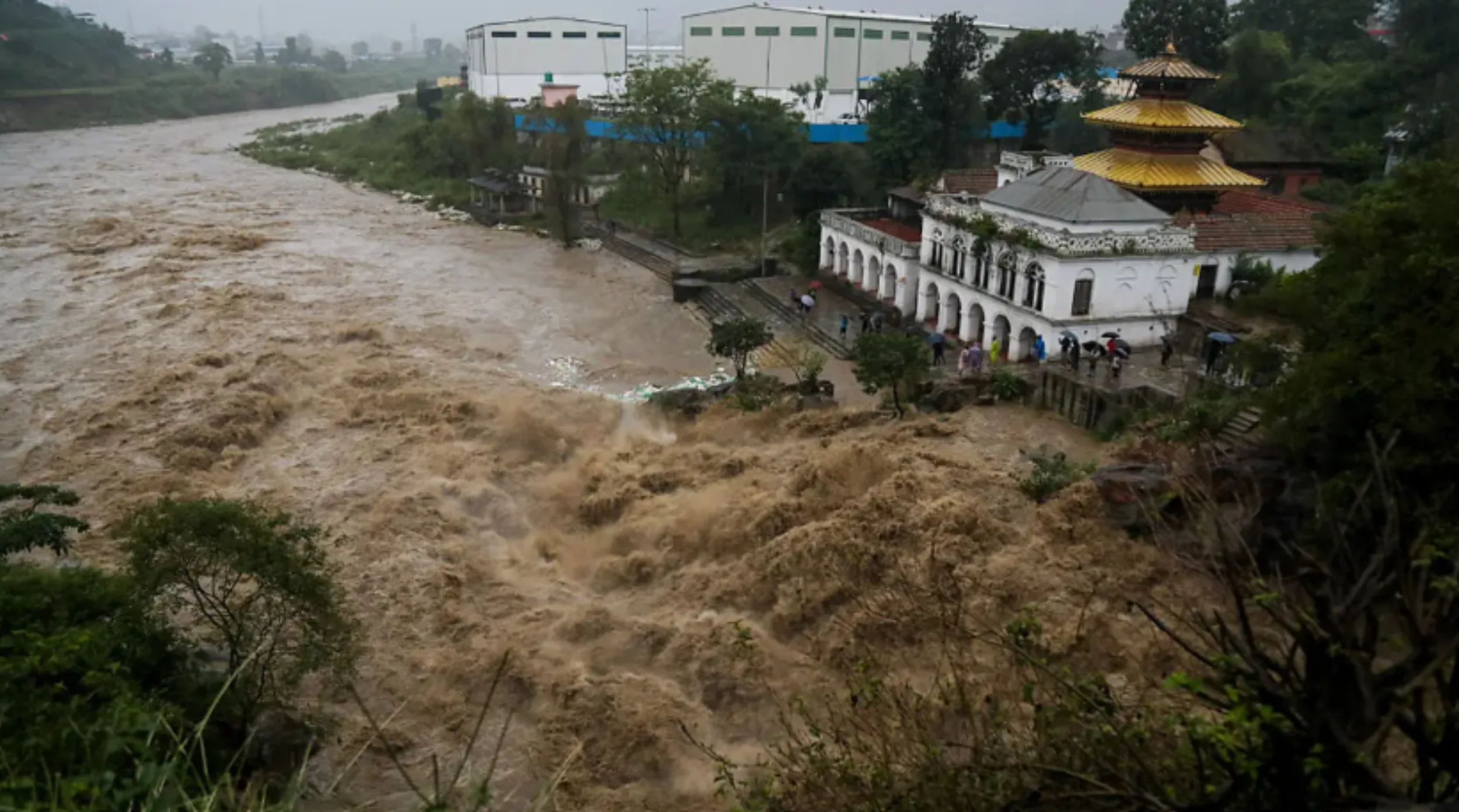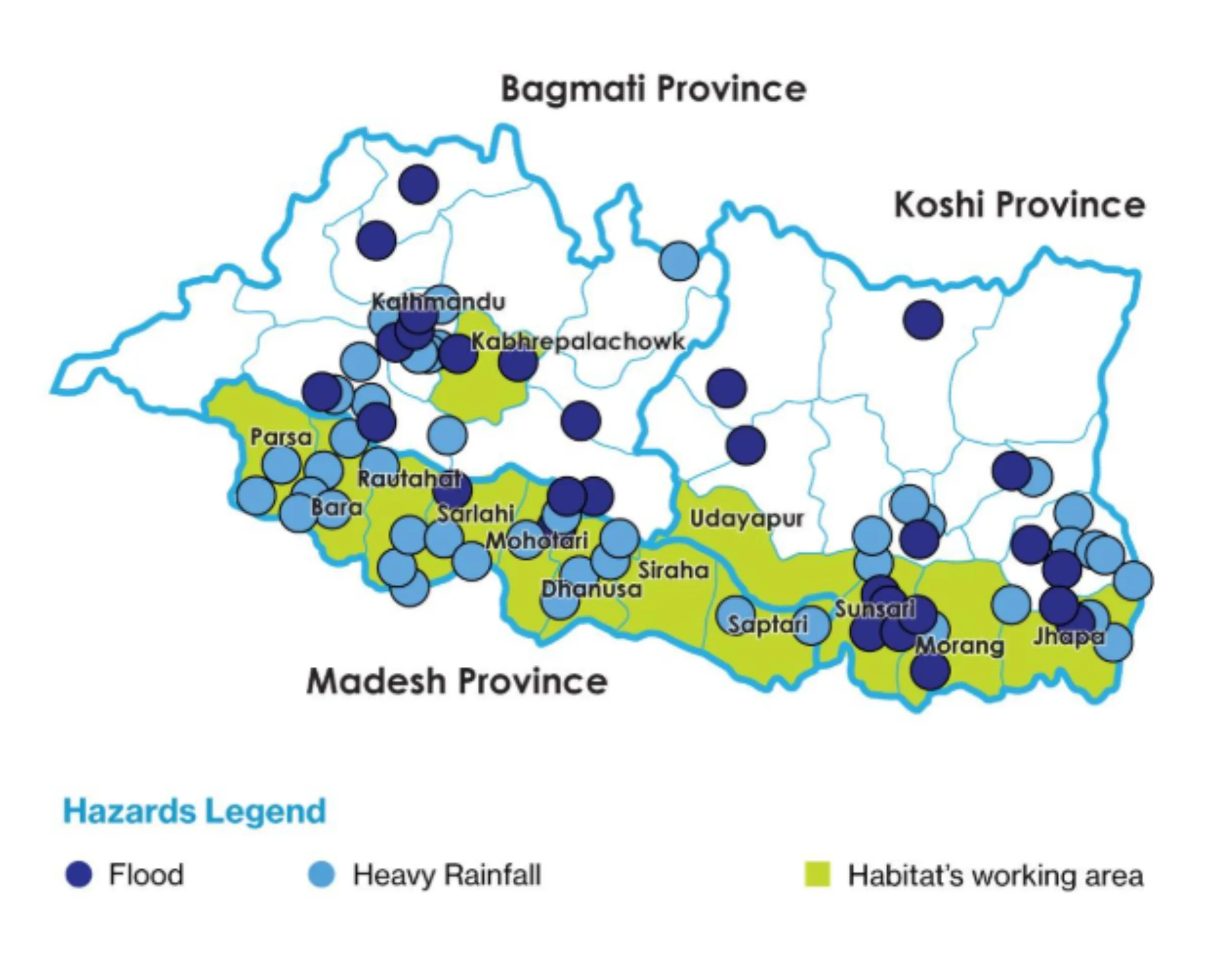Nepal was hit with a devastating flood in early October. Thousands of affected families urgently need safe shelter and support to rebuild their lives.
Torrential rains between 4 – 5 October 2025 caused fast-moving floods and landslides across Bagmati, Madesh, and Koshi Provinces in Eastern and Central Nepal, affecting over 30,000 families.
In the rural district of Jhapa alone, nearly 5,000 homes were damaged and more than 1,900 families were displaced.
In response to the floods, Habitat for Humanity Nepal activated its Emergency Response Coordination team to lead the response and ensure coordination with government authorities and organisations. Habitat Nepal has a strong presence across the lower Terai belt in Madesh and Koshi Provinces, where majority of the destruction from these floods is concentrated.
Within 48 hours, Habitat Nepal’s team dispatched 125 emergency shelter and repair kits from its existing supplies.
Now with floodwaters receding, many displaced families are returning from the evacuation centers and higher grounds to discover what’s left of their homes and fields.
In the wake of such damage and displacement, a new phase of recovery must begin.
Habitat in New Zealand has a long-standing relationship with Habitat for Humanity Nepal. Our organisation and Kiwis across the country supported Nepalese communities to recover and rebuild after the tragic 2015 earthquake. To join us now in supporting affected families in Nepal, click below.
In the second phase of recovery after this natural disaster, Habitat Nepal will identify and support 350 families to clear debris and repair partial shelter damage. They will also support local governments with the technical knowledge needed to carry out damage assessments.
For families whose homes have been swept away or are now too unsafe to return to, Habitat Nepal will support 125 families to construct transitional shelters.
Local materials like bamboo will be used for transitional shelters. Bamboo is a culturally appropriate, affordable and green building material. Families are familiar with bamboo and use them in construction, so they can work quickly when setting up these transitional shelters.
For Lilmuni, the recent flood was unlike anything she had ever experienced. Every year, the nearby river overflows a little, and the villagers have learned to live with it. But this time, it was different. The entire village and surrounding areas were swallowed by the floodwaters.
Lilmuni’s house was completely destroyed. The rushing water took away her beds, mattresses, utensils, stored rice, grains, and crops. She lost everything; even her animals were swept away.
Today, Lilmuni has no safe place to sleep. With her home gone, she now finds temporary shelter with other women in the village, holding on to hope that one day she can rebuild what was lost.
Surujmuni, 28, lives with her father-in-law, mother-in-law, and two young children. Her husband is currently in India, working to support the family.
On the morning of the flood, around 5am, Surujmuni was at home with her family when the police arrived for rescue operations. Her children and in-laws were safely taken to higher ground, but Surujmuni decided to stay back, worried about her cattle, crops, and stored food.
Soon, the water began to rise rapidly. Despite her efforts, she couldn’t save the grains, utensils, clothes, or her home; everything was washed away. Still, she managed to save her cattle and her own life. Fortunately, there were no human casualties in her area that day.
Now, her children are staying with her parents. Surujmuni has no proper place to live or sleep. The community has come together to prepare meals for everyone, and some families are still sheltering in local schools due to fear of another flood.
If you wish to make a donation via credit card over the phone, please phone us on (09) 579 4111
You can donate via internet banking:
Habitat for Humanity New Zealand
ANZ
06-0177-0127197-00
If you wish your donation to go to a specific appeal please include in the payment Reference
If you make a donation on our website your receipt will be emailed to you automatically.
If you choose to donate via internet banking, you will receive your receipt via email 1-2 days after you make your donation. If no email address is given, your receipt will be posted to the address given.
Donations over $5.00 are tax deductible. You can submit your receipt to IRD website, and they will process your tax rebate.
Yes, you can give regular monthly donations to your chose Habitat for Humanity appeal. Just select 'give monthly' when processing your donation payment.
You can change, cancel or suspend your monthly donation at any time. Please email us at info@habitat.org.nz, or phone us on (09) 579 4111.
Your credit card will be charged once you submit your first monthly gift, and future donations will be made on that same day going forward. If you wish to change your payment date to better suit your pay cycle, please get in touch via information@habitat.org.nz, or phone us on (09) 579 4111 and we can easily action that for you.
Yes, you will receive an annual tax receipt at the close of the financial year, recording all donations.
Yes, if you wish to donate via internet banking, our details are
Habitat for Humanity New Zealand
ANZ
06-0177-0127197-00
If you wish your donation to go to a specific appeal, please enter into your Reference
One tax receipt recording all your donations for the financial year, making it easy to claim your tax rebate.
With small payments spread out month to month, becoming a HopeBuilder can suit any budget. Even a small amount can have a huge impact.
Your donation occurs automatically each month, and you can pause, downgrade, upgrade, or cancel at any time.
Your regular support ensures long-term impact, all year long.
Please fill in the below enquiry form and we will be in touch soon.
Please fill in the below enquiry form with your details and we will be in touch within 2 working days.






